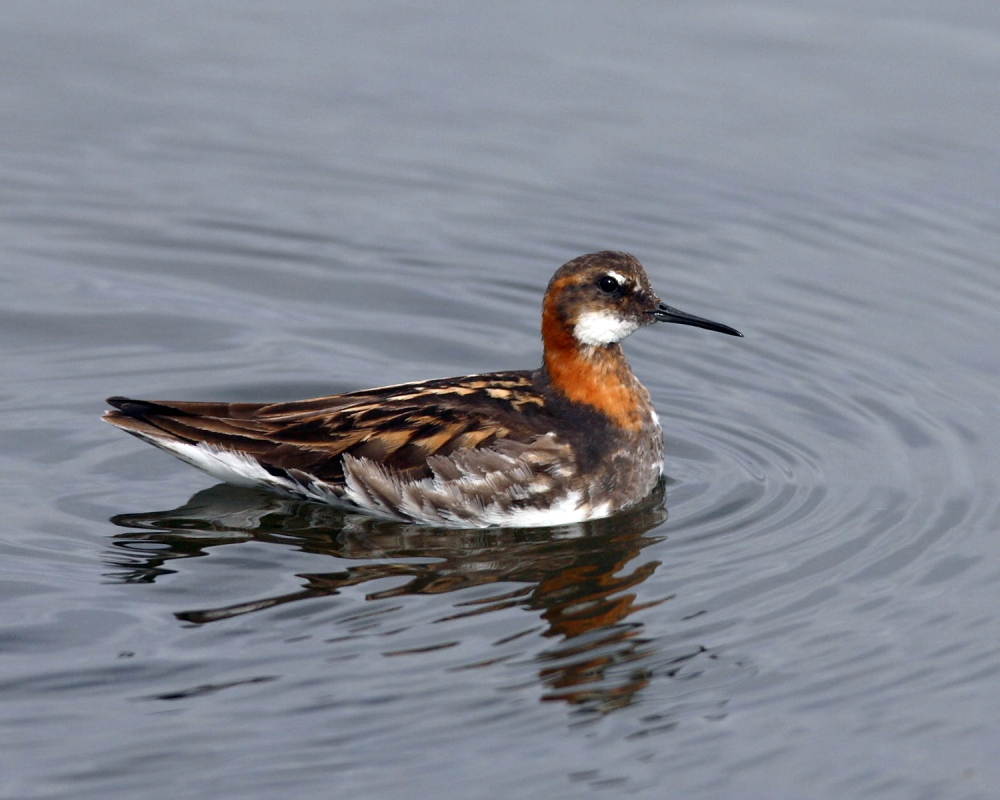Blagdon Lake Birds
Red-necked Phalarope Phalaropus lobatus [Linnaeus, 1758]
(Extremely rare PM)

- One obtained, not aged, 21st Sep. 1921 (D. Carr).
- Several, not aged, autumn 1921 (D. Carr).
- One, not aged, autumn 1931 (D. Carr).
- One, juvenile, 23rd Aug. 1999 (N.R. Milbourne).
- One, juvenile, 18th-27th Sep. 1965 (P.J. Chadwick, R.M. Curber, T.B. Silcocks et al.).
- One, juvenile, 21st-30th Sep. 1996 (K.J. Hall et al.).
- Two, juveniles, 25th-26th Aug. 1999 (R.J. Ingram et al.).
- One, moulting juvenile, 4th-5th Oct. 2010 (M.I. Pearce, R. Mielcarek, A.H. Davis et al.).
A tiny, widespread, wader that breeds mainly in the Holarctic tundra with just a few pairs breeding on the Shetland Isles and the Outer Hebrides in Great Britain and Ireland. Red-necked Phalaropes are long distance migrants that winter on the sea off Ecuador and Peru, drawn there by the rich upwelling of the Humboldt Current, Arabia and the south west Pacific where they feed on plankton.
The first acceptable record was of a bird 'obtained' (so, presumably shot) in September 1921 according to Howard H. Davis with the actual date being given as 21st by Eileen Palmer and David Ballance in their 1968 publication of The Birds of Somerset, in which it is listed as the first county record. There were no records given in Cecil Smith's earlier county avifauna, written before the reservoir was built, suggesting that the species is appearing more frequently these days.
The autumn 1931 record was said to have been of this species in Somerset Birds 1932, but another note from A Revised List of the Birds of the Bristol District (H.H. Davis) attributes Blagdon Ranger Donald Carr as reporting a phalarope, without corroborative details, in the 1931 Report of the Wells Natural History and Archaeological Society. This record must be considered as not proven at this stage, though I shall attempt to get more details from the Wells Library in due course. We had a wait until 1965 for the second record of Red-necked Phalarope at Blagdon when an immature bird was seen by several observers and filmed by Harry Thornhill during its ten day stay.
There was another long wait for the 3rd record, a juvenile found by Ken Hall in front of the Lodge on 21st September 1996. Like the last bird, this one also stayed for ten days. On the 23rd August 1999, Nigel Milbourne spotted a phalarope in the centre of Top End feeding among hirundines, whilst scanning from Rainbow Point, which was suspected as being a Red-necked. Local birders were called and joined forces to try and establish specific identity. However, it wasn't seen again, but while birders searched, MJ phoned from Chew Valley Lake to report having seen a juvenile Red-necked, fly out from Heron's Green Bay towards the centre of the lake. This was possibly the same bird but, rather intriguingly, Richard Ingram visiting Blagdon two days later found two juvenile Red-necked Phalaropes feeding together. The author had searched Blagdon carefully on the 24th August without finding the bird seen earlier, so could the Blagdon bird have flown to Chew, met up with another there and then come back to Blagdon where they were found by Richard two days later? Alternatively, it is possible that these were new birds that were part of a general movement through the country. Either way, Richard's two birds become the 4th lake record (5 birds) and were seen by several observers during their short stay.
Eleven years later, Mervyn Pearce found the next off Bell's Bush at lunchtime on 4th October 2010 in low water conditions, so often a feature of occurrences at the lake. A call to Richard Mielcarek and Andy Davis, birding at Chew, got them over to help establish the age and identity of this individual which could only be viewed at distance. It stayed for two days and unfortunately didn't come close enough to allow a good photograph to be taken.
Bibliography (sources of information):
- Blaythwayt, Rev F.L. (ed.). Report on Somerset Birds, 1932. Somersetshire Archaeol. & Nat. Hist. Soc.
- Carr, D. Report, Wells Nat. Hist. & Archaeol. Soc. for 1931.
- Davis, A.H. (ed.) Avon Bird Report, 1996. Avon Ornithological Group.
- Davis, A.H. (ed.) Avon Bird Report, 1999. Avon Ornithological Group.
- Davis H.H. 1948. A Revised List of the Birds of the Bristol District. Reprinted from the Proc. of the Bristol Naturalists' Society, vol. XXVII, part IV, pp. 225-268. 1947.
- Davis, H.H. (ed.). Bristol Bird Report, 1965. Bristol Naturalists' Society.
- Davis, H.H. (ed.). Somerset Birds, 1965. Somersetshire Archaeol. & Nat. Hist. Soc.
- McGeoch, J.A. (ed.). Somerset Birds, 1968. Somersetshire Archaeol. & Nat. Hist. Soc.
- Palmer E.M. & Ballance D.K. 1968. The Birds of Somerset. London.
- Rose, Dr H.E. (ed.). Avon Bird Report, 2010. Avon Ornithological Group.